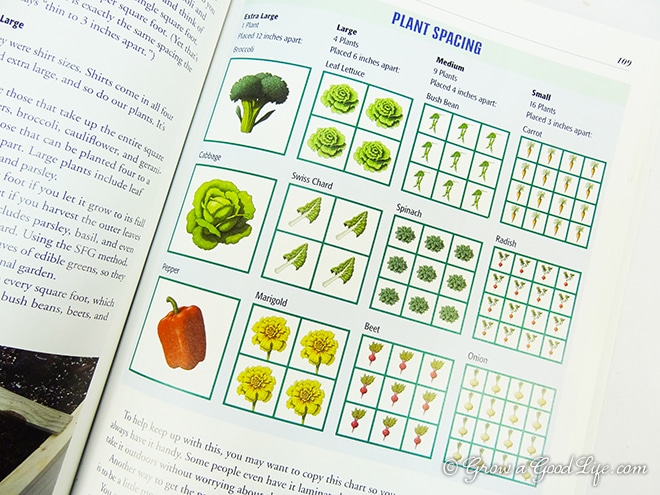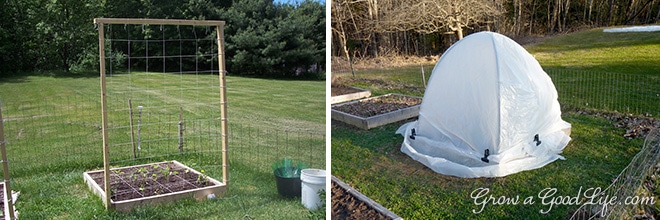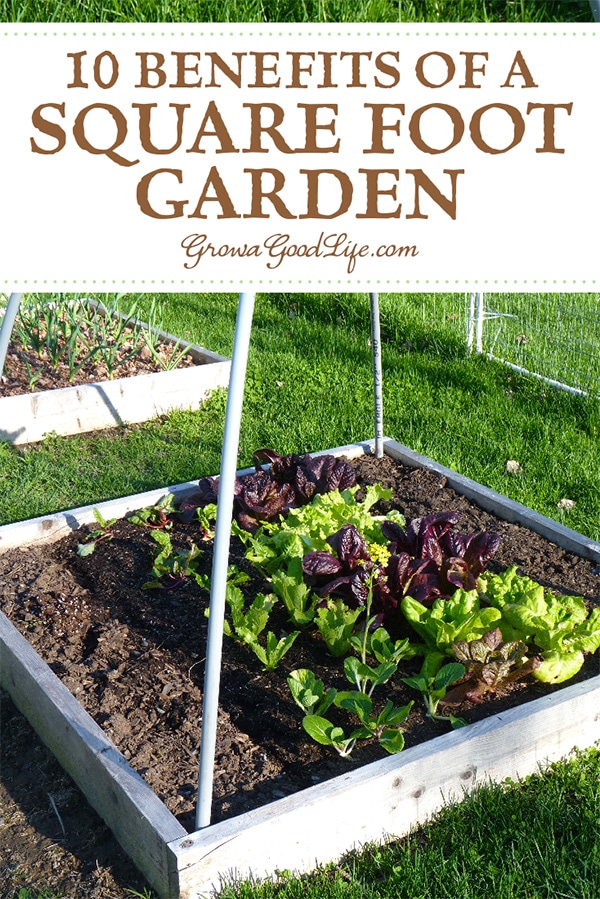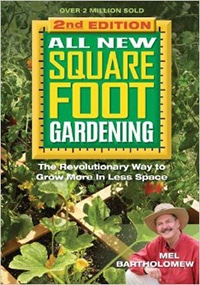10 Benefits of a Square Foot Garden
This post may contain affiliate links, which means that I may receive a commission if you make a purchase using these links. As an Amazon Associate I earn from qualifying purchases.
If you are just starting a garden or want to expand your growing space, the Square Foot Gardening method is worth considering. The beds are easy to build with no digging or tilling required.
 I grew up in a small town where my parents and extended family tended several vegetable gardens on our property. Each spring, the gardens were layered with manure delivered by a local farmer, and tilled into the native soil. Then the soil was raked and planted with long rows of vegetables.
I grew up in a small town where my parents and extended family tended several vegetable gardens on our property. Each spring, the gardens were layered with manure delivered by a local farmer, and tilled into the native soil. Then the soil was raked and planted with long rows of vegetables.
My grandparents and great aunt did most of the work in the gardens over the growing season. As a child, I remembered that involved a lot of weeding and hoeing, weeding and hoeing. They probably enjoyed working in the garden each day, but to me it seemed like a chore.
When I purchased my home, I was thrilled that it came with a small vegetable garden bed. I dreamed of growing a garden like my grandparents did, filling the freezers and pantry with homegrown vegetables.
The first year wasn’t stellar. The garden beds were infested with weeds, the soil was in poor shape, and I quickly discovered that I didn’t have enough time to weed and hoe each day. The good news was that even with the challenges I was able to harvest enough veggies to feed us. I was optimistic by what I could grow and I knew I could get more yields for my efforts if my veggies didn’t have to battle the weeds for water and nutrients. I had to do something different.
Over the winter of 2009 I began reading All New Square Foot Gardening by Mel Bartholomew. I decided to test the square foot gardening method out by adding three 4×4 square foot beds to the south end of our garden area. We built, filled, and planted these beds in just a weekend.
You can see the details of the building process here: How to Build a Square Foot Garden. The vegetables planted in these beds did very well.
What is Square Foot Gardening?
The square foot garden model was developed by Mel Bartholomew and explained in the book, All New Square Foot Gardening originally published in 1981. The book has been updated several times over the years with revised information and additional projects to enhance your square foot garden. Since it works so well, the original concept of square foot gardening remains the same.
The basic concept of square foot gardening involves building a small garden bed out of 2×6 inch boards, filling the bed with a soil blend called Mel’s Mix, dividing the bed into one-foot sections, and planting each square according to the plant spacing described in the book.
The square foot gardening method continues to be a popular way to grow an intensive vegetable garden in less space and with less work.

10 Benefits of the Square Foot Garden Method
I loved gardening in our newly built square foot garden beds so much that I added more when I extended the garden over the years. They continue to be a great way to garden and are easy to build making it so quick and easy to expand the garden area.
Some of the benefits to square foot gardening:
Quick Setup: Square foot gardening is a quick way to start a new garden or expand a garden. Once you have gathered your material, you can build, fill, and start planting the same day.
Easy to Plan: The square foot gardening concept is simple and organized. Since the beds are divided into squares, it is easy to plot your growing beds according to the charts in the book.
No Digging: You don’t have to worry about digging a garden because the raised beds are placed on top of the ground eliminating the need to dig or till a garden. The grass decomposes naturally beneath the bed.
Start with Healthy Soil: Building raised beds and filling with quality soil gives you an immediate advantage over a regular garden because you are starting out with soil that is rich in nutrients and organic matter.
No Soil Compaction: Since you never walk on the beds, the soil stays loose and is able to hold water, provide oxygen to the plant roots, and maintain a flourishing microbiological environment that is ideal for plant growth.
Warmer soil: The soil in raised beds drains and warms quicker in spring allowing you to start planting spring greens sooner. In addition, heat-loving plants such as eggplant, peppers, and tomatoes prefer a warm soil so they will flourish in raised beds.
Less Weeding: Since you are starting with fresh soil, there are fewer weeds for the first few years. Intensive planting also shades the soil and helps prevent weeds from growing. Weed seeds do blow in over time, but they are easy to manage. Weeds pull out easily since the soil is fluffy and loose.
Easy to Water: Since the beds are small, it is easy to provide moisture to the crops and not waste water by watering the paths or rows in between. The soil mix absorbs and holds water. The close spacing also helps shade the soil preventing moisture loss.
Greater Yield: Growing in raised beds with healthy, nutritious soil allows you to plant closer. Since there are no paths between rows, there is no wasted space. This intensive planting results in a greater yield from your square foot garden than regular garden space.
Easy Upkeep: Just like all living things, soil needs to be fed in order to provide a healthy environment to grow your vegetables. Simply adding organic matter each year will maintain the texture of your soil and replenish nutrients.
Adding a trellis to the north side of the bed allows you to grow vining crops such as pole beans, indeterminate tomatoes, or cucumbers. Crisscross two 10-foot pieces of PVC and you have a dome that you can drape with plastic for some frost protection, deer netting to keep critters out, or row covers to keep insects off the plants.

Over the years, the garden has expanded to include additional raised beds. Adding fresh compost each year has helps maintain the soil’s fertility. Although there were minimal weeds in the beginning, over time a few began to pop up. But they are much easier to control than my other beds.
I still use the recommended Square Foot Gardening plant spacing in most of my raised beds. Some have been adjusted over the years to accommodate my growing conditions or the varieties of plants I grow. The garden is an ever evolving and ever growing process, but it was encouraging to have a fresh start.
If you are just starting a garden or want to expand your growing space, the Square Foot Gardening method is worth considering. The beds are easy to build with no digging or tilling required.
This article was originally published on April 3, 2013. It has been updated with additional information, photos, and video.
More Gardening Articles:
- How to Build a Square Foot Garden
- 7 Tips for a Low Maintenance Vegetable Garden
- Planning Your Vegetable Garden: Mapping the Garden Beds
- How to Make Your Own Seed Mats or Seed Tapes
- How to Harden Off Seedings



Thanks for this article on Square Foot Gardening. Next year, 2016, will be the 40th Anniversary of when Mel introduced SFG in celebration of America’s Bicentennial. Starting in January the Square Foot Gardening Foundation will have drawings and contests and events, culminating in “World SFG Day” on July 1, 2016. Join us on Facebook at: Square Foot Gardening Foundation or Square Foot Gardening 4 U beginning in January for more info.
I’ve never tried square foot gardening, great idea!
Thanks for linking up with Green Thumb Thursday. I hope to see you again this week!
~Lisa M
My curiosity comes in the question of root vegetables…how deep do I really need to make my raised beds for things like carrots and radishes?
Dawn, 6-8-inches deep will work for most vegetables including radishes and shorter carrots. You can also loosen up the soil beneath the bed using a digging fork to allow longer carrots to penetrate deeper. Of course this depends on the quality of soil beneath the bed. There are many shorter type carrots, such as Parisian or Little Finger that will grow very well in raised beds.
Rachel, your article is WONDERFUL! Two corrections: instead of breaking up soil underneath the bed (there’s weed cloth under the beds) Mel suggests making a 1′ x 1′ wooden “Top Hat” on top of just that one square and putting in additional Mel’s Mix growing medium. That means you don’t have the expense of 12″ high wood AND you save money on Mel’s Mix because you’re only making that single square deep.
Also Mel suggests adding a trowel of compost EVERY time you harvest a square not just once a year.
Thank you for introducing Square Foot Gardening to your readers and thank you for acknowledging Mel. There are many others calling what they do SFG but it’s just plain ol’ raised bed gardening. Mel’s Mix is CRITICAL because all high-intensive gardening uses a lot of nutrients. Mel’s Mix and the use of the grid on top of the soil differentiate SFG from other forms of raised bed gardening.
~ Kim Roman – Certified Square Foot Gardening Instructor (taught by Mel)
Just a quick word, here. I don’t use raised beds except for one 12 x 48 area I cover with plastic in the fall and call a high tunnel. Back in the 50’s, a lady named Ruth Stout published her method of gardening. It is an no-till way of going about things, Just cover everything with a thick (6 to 8 inch) layer of mulch and when a weed comes along, throw more mulch at it and it goes away. Over time, the mulch rots and becomes compost. To plant, mark out where you want your row or block, rake the mulch aside, plant and push the mulch back in place. No hoeing! I always considered this to be a waste of precious time.
Thanks for listening to an old guy with a soap box. Love the newsletter! Keep up the good work! Very helpful!